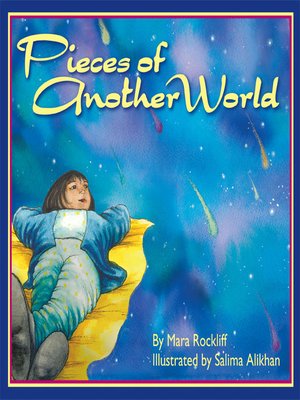Category: Children’s Book
Reviewed by: Marianne Dyson
Title: Pieces of Another World
Author: Mara Rockcliff
Illustrator: Salima Alikhan
Reading Level: Ages 5-9
NSS Amazon link for this book
Format: Hardcover
Pages: 32
Publisher: Sylvan Dell
Date: September, 2005
Retail Price: $15.95
ISBN: 0976494329
Pieces of Another World is about a father getting his daughter up to go see a meteor shower. The father and daughter drive to an ice-cream store, past a popular swimming hole, and then out into the country to watch a meteor shower from the back of a pickup truck. The main character is a girl who first thinks the “other world” is the ice cream parlor at night because it is full of teenagers on dates. Then she thinks the “other world” is the town at night with deer, fox, and owls. Finally, they park the truck and she sees her first shooting star. Following the story is a set of definitions, a multiplication problem (how many would you see in 10 seconds, in one minute, etc.), tips for a meteor-watching party, a recipe for Comet Cookies, and a diagram of a Comet’s Orbit.
Most parents and grandparents should enjoy reading this book to a young child, and they should be prepared to take them outside afterwards! The best time to read this book is in the summer before the August Perseids, so that a “party” can be planned. (My sources say the Leonids in November are not worth your time because the bulk of material is gone now.) My only disappointment with the story is that the father does not share the common tradition of having the girl make a “wish upon a star.” Their conversation is a rather contrived “data dump” of facts that does not fit well with the solving of the mystery of seeing another world. But it ends well, and I think most readers will forgive the short data “intrusion.”
The illustrations were lovely watercolors with a dreamy quality that suited the story perfectly, though I couldn’t help but notice that the girl’s coat goes missing and then reappears, along with a cup losing its stripes.
The “Creative Mind” definition page had all the essentials for a parent to answer questions children are likely to ask about meteors. However, no mention is made that asteroids sometimes get bumped out of their orbit and become meteors. In fact, most meteorites (the ones that make it to the ground) are asteroids, not parts of comets, and make outstanding shooting stars.
The “Meteor Watching Party” directions made me want to schedule one! However, one thing was missing: bug spray – especially for us southern observers who must avoid disease-carrying mosquitoes. I was glad to see mention of other things that they might see while watching the sky. Airplanes do not have red blinking lights. They have white strobe lights on the ends of their wings, and a white steady light on their tails. They have a red light on the port wing, and a green one on the starboard wing, but these do not blink. They also have headlights used on approach and landing (if you see one of those, get out of the way!).
The “Comet Cookies” activity is not the best analogy to the real motions of the Earth and comets. It says to lay the cookie on a plate and make a tail out of leftover candy/chip mix. (Three tablespoons for each cookie is a lot of leftover mix!) Then it says to use a lamp for the Sun and shake this tail off while flying the comet around it. Yikes! Chocolate chips melt easily, and can burn and smoke if they fall onto the hot bulb or the lampshade. Kids will surely enthusiastically shake chips all over the lamp, table, the room, and themselves. Then we’re supposed to encourage the kids to roll a ball through this mess? The directions say to make the comet’s orbit an ellipse, but then they don’t say that the Earth’s orbit is a circle. I’m not sure that kids will know this, though it is shown in the illustration on the next page. The child should push the ball rather than roll it to simulate the correct orbital motion. (The Earth spins around the axis perpendicular to the plane of the table, so it does not “roll,” it “skids” with the “dawn” side always forward.) An opportunity was missed in the illustration to show where the comets come from: either the Kuiper Belt (for short-period comets) or the Oort Cloud (for long-period comets). Still, I am a fan of activities, and while it would be a real mess to do this one, I’m sure the kids will enjoy it.
Pieces of Another World is a heart-warming story that will educate and excite children to watch the sky and encourage parents to observe with their children.
© 2006 Marianne Dyson
Please use the NSS Amazon Link for all your book and other purchases. It helps NSS and does not cost you a cent! Bookmark this link for ALL your Amazon shopping!



















